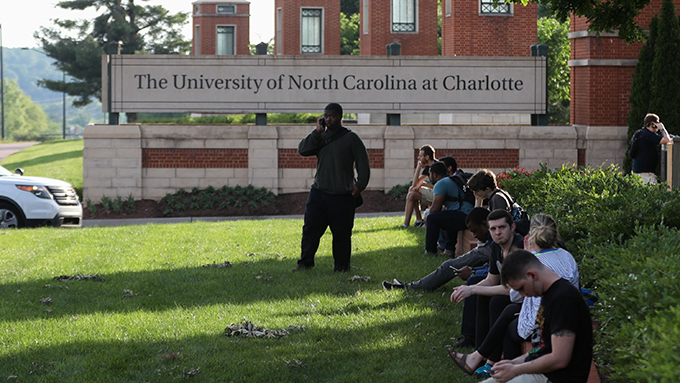
The April 30 shooting at the University of North Carolina at Charlottefollows a familiar pattern of mass shootings at college campuses in the United States.
If authorities better understood these patterns, they may be able to prevent future shootings.
We’re a psychologist and sociologist who have been studying mass shooters in order to develop new prevention strategies. Our research is part of a grant from the National Institute of Justice.
Part of our work involves looking at the psycho-social life histories of mass shooters from 1966 through the present, as well as the kinds of places where mass shootings occur.
Mass shootings are defined by the FBI as incidents in which four or more people are killed. When mass shootings occur on college campuses, it tends to be at larger, public universities like UNC Charlotte.
Strikingly, more than 70% of campus shootings took place at the end of the school year – in April, May or June – a time that students report as being the most stressed. The shooting at UNC Charlotte took place on the last day of classes of the semester.
Indeed, April stands out as a particularly deadly time of the year when it comes to campus mass shootings – the 2007 Virginia Tech massacre that claimed 32 lives, and the 2012 Oikos University shooting in Oakland, California, that killed seven and wounded three, both happened in April.
Characteristics of campus shooters
The UNC Charlotte shooting is not technically a mass shooting because there were only two fatalities. Two students were killed and four were injured as they listened to final presentations in class.
So far, little is publicly available about the UNC Charlotte shooter, but the details emerging show he shares some of the same characteristics as the campus shooters in our data. The UNC Charlotte shooter is a 22-year-old former student of the school who recently dropped out.
All of the college mass shooters in our study were male, and the majority – 83% – were in their 20s. Unlike mass shooters at middle at high schools who are mostly white, the majority of mass shooters at college campuses – 83% – were non-white. More specifically, 50% were Asian and 33% were mixed-race. All but one was a current or former student at the university.
All of the university mass shooters in our study were suicidal prior to the shooting and had a history of mental illness. Half had been previously hospitalized. The majority of mass shootings at universities involved a high degree of planning. Most of the mass shooters leaked their plans ahead of time, or at least showed signs of trouble, on social media, to mental health professionals, or to people they knew.
According to publicly available records, all of the university shooters in our database legally purchased their firearms. We do not know yet how the UNC Charlotte shooter obtained his guns.
Troubled histories
All of the university mass shooters in our study experienced childhood trauma, and two-thirds were known to have been previously bullied. Analysis of the cases in our database shows that the majority of university mass shooters had a history of previous violence. The background history of the UNC Charlotte shooter is currently unknown.
Reported prevalence rates of university shootings vary widely depending on the definition being used. A study of college shootings from 2001 to 2016 identified 149 incidents of gun violence on college campuses, though the vast majority were the result of a dispute, a targeted attack, a robbery or domestic violence.
Our database starts with the 1966 mass shooting at The University of Texas at Austin, widely considered the first mass shooting in modern American history. When focusing on the past 20 years of our data, however, we identified six mass shootings on college and university campuses that meet the FBI definition of a mass shooting, which is the same number of mass shootings at K-12 schools.
The deadliest attack, at Virginia Tech University in 2007 in which 32 people died, changed the nature and role of public safety departments at universities across the country. The recommendations to universities after Virginia Tech mirrored those made to high schools after the 1999 Columbine shooting, including increased cameras and security, communication systems, and increased training and drills for faculty and staff. However, prevention strategies have been difficult to identify and implement at universities due to a lack of research and resources.
Prevention is possible
Our data shows a distinct pattern in the background of university mass shooters that can help authorities think proactively about evidence-based prevention. University mass shooters are students with histories of trauma, mental illness and violence. They are often actively suicidal and in crisis.
Large universities need strategies to reach out and connect with vulnerable students. Current university funding for mental health care on campus is largely inadequate. And, if they aren’t already getting it, faculty and staff need training in how to identify and respond to students in crisis.
Threat assessment teams at universities can respond to threats of violence by connecting students to needed resources on campus and in the community with long-term follow-up. And the findings from our research suggest red flag laws, which allow family or law enforcement to seek a court order to seize a person’s firearms temporarily if the person poses a threat to himself or others, coupled with universal background checks, which would require background checks for private gun sales, not just those by licensed dealers, may help avert these tragedies.
Author Bios: Jillian Peterson is a Professor of Criminal Justice at Hamline University and James Densley is also a Professor of Criminal Justice at the Metropolitan State University
